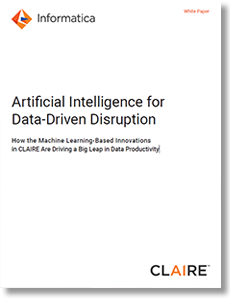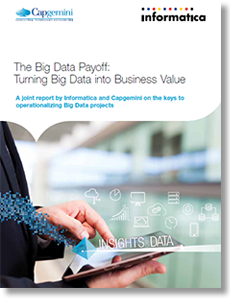How The Chicago Cubs Baseball Team Brought Data Driven Decision Making to Wrigley Field

Graeme Thompson, senior vice president and chief information officer of Informatica talks with Andrew McIntyre, VP of Technology for the Chicago Cubs, together they explain how the franchise is using data to re-imagine processes and strategies - both on the field and within the business.
It’s hard not to like the travel side of my job.
I get to meet customers and peers, attend conferences and events, and share experiences around data and digital transformation.
But, as a rabid baseball fan, my September trip to Chicago was really special: I took a “backstage” tour of Wrigley Field with Chicago Cubs VP of Technology Andrew McIntyre.
I fell in love with baseball after visiting San Francisco in the mid-nineties and getting caught up in the excitement around the Giants.
Luckily for a kid from Scotland, I had hardcore baseball fans to explain the intricacies and strategies of the game.
And here I am in 2017, working with the reigning World Series champions and walking through one of the best-loved parks in baseball.
Apart from the sheer pleasure of touring the historic stadium, I learned a lot about the transformation the Chicago Cubs have undergone in the last few years, driven in large part by data.
The Focus on The Fan
When the Ricketts family bought the Cubs in 2009, they made three promises that drive all their strategic decisions:
- Win the World Series
- Be good neighbors
- Make use of their best asset, Wrigley Field
Every decision, Andrew told me, is filtered through those three overarching commitments, all of which are about making the fans happy.
As the business’s VP of technology, one of Andrew’s chief focus is on using data to enhance the fan experience.
The idea of a “customer 360” perspective, using data to improve every interaction, is a hot topic these days. Often it centers on how to provide the best online experience, and how to anticipate what digital information or offer a customer wants at any given moment.
For Andrew’s team and his historic building, that includes some unique challenges, such as using crowd flow data to determine the best locations for concessions and bathrooms to improve the in-park experience.
They’re also working to better identify which ticket holders are in the park, to understand what they want and need, and what promotions will excite them most. Which is much harder than it sounds.
Groups of people sometimes go in together on season tickets, so who do you tailor today’s game experience for? Andrew’s team has been working on ways to better know who’s showing up to each game, and finding ways to customize the digital experience for that specific fan.
And that’s just the day-to-day business. The Cubs also have to be prepared for the kinds of surges that can crush a business’s IT infrastructure. For instance, in the 24 hours after winning the 2016 World Series, the team sold more than $70 million in merchandise, online and in retail locations. You’ve really got to have your IT act together to support that kind of demand.
Concrete Challenges
I talk to CIOs all the time about technical debt and legacy challenges, but in our modernization at Informatica, and in the case of most IT leaders I talk to, our legacies might be databases or applications reaching back to the 1990s. But Wrigley Field is 103 years old. That’s a challenge of physical infrastructure that I’ve not seen before, and it can be a big factor.
Of course, Wrigley’s not a burden - it’s a widely beloved asset, which is why they’re renovating the park, even as they play, rather than building a new stadium from scratch. (It had never occurred to me that the team’s success was an enemy here, but when you make it into the playoffs or all the way to the World Series, your off-season is a month shorter, giving you less time for construction efforts.)
Live from Wrigley Field
The day I walked through the park with Andrew, the Cubs were just going through batting practice ahead of playing the Mets (the Cubs won, 17-5). He showed me the Cubs data center, and the replay room, which was an intense media hub full of monitors and frenetic activity.
I asked Andrew about other key aspects of running a data organization, such as culture and staffing. Baseball is lucky in that it draws fans into the business, people who really love being a part of the organization. But I asked about the flip side, which is that when your team is barreling through the 2016 postseason, and just now entering the 2017 playoffs, how do you and your IT team stay focused on work?
Andrew just smiled. The mission-critical work always gets done, of course, but you do make some allowances for the level of excitement around the game itself. As I write this, the Cubs are just entering the playoffs. So I’m hoping he won’t have time to talk data with me for another month, at least.
Source: Informatica Blog
About the Author
Graeme Thompson is senior vice president and chief information officer (CIO) of Informatica with responsibility for the strategic direction of Informatica’s global business solutions and technology infrastructure. Graeme’s focus is on fostering a world-class IT organization and furthering Informatica’s use of cloud, big data and other technologies to create competitive advantage, enable new revenues and aid in driving customer success.
Related Article: Advanced Analytics: 9 Insights from the C-Suite
Related White Papers
Artificial Intelligence for Data-Driven Disruption
This paper details how Informatica’s CLAIRE engine which uses artificial intelligence and machine-learning techniques powered by enterprise-wide data and metadata, significantly boosts the productivity of all managers and users of data across an organization. Download Now!
The Big Data Payoff: Turning Big Data into Business Value
Commissioned by Capgemini and Informatica, this report assesses the business value and benefits that enterprises are seeking and realizing from Big Data. Download Now!
More Resources on Artificial Intelligence
Article Topics
Informatica News & Resources
Artificial Intelligence for Data-Driven Disruption The Big Data Payoff: Turning Big Data into Business Value How The Chicago Cubs Baseball Team Brought Data Driven Decision Making to Wrigley Field Easter Bunnies and Supply Chain TraceabilityLatest in Technology
South Korea Finally Overtakes China in Goods Exported to U.S. SAP Unveils New AI-Driven Supply Chain Innovations U.S. Manufacturing is Growing but Employment Not Keeping Pace The Two Most Important Factors in Last-Mile Delivery Spotlight Startup: Cart.com is Reimagining Logistics Walmart and Swisslog Expand Partnership with New Texas Facility Taking Stock of Today’s Robotics Market and What the Future Holds More Technology
















